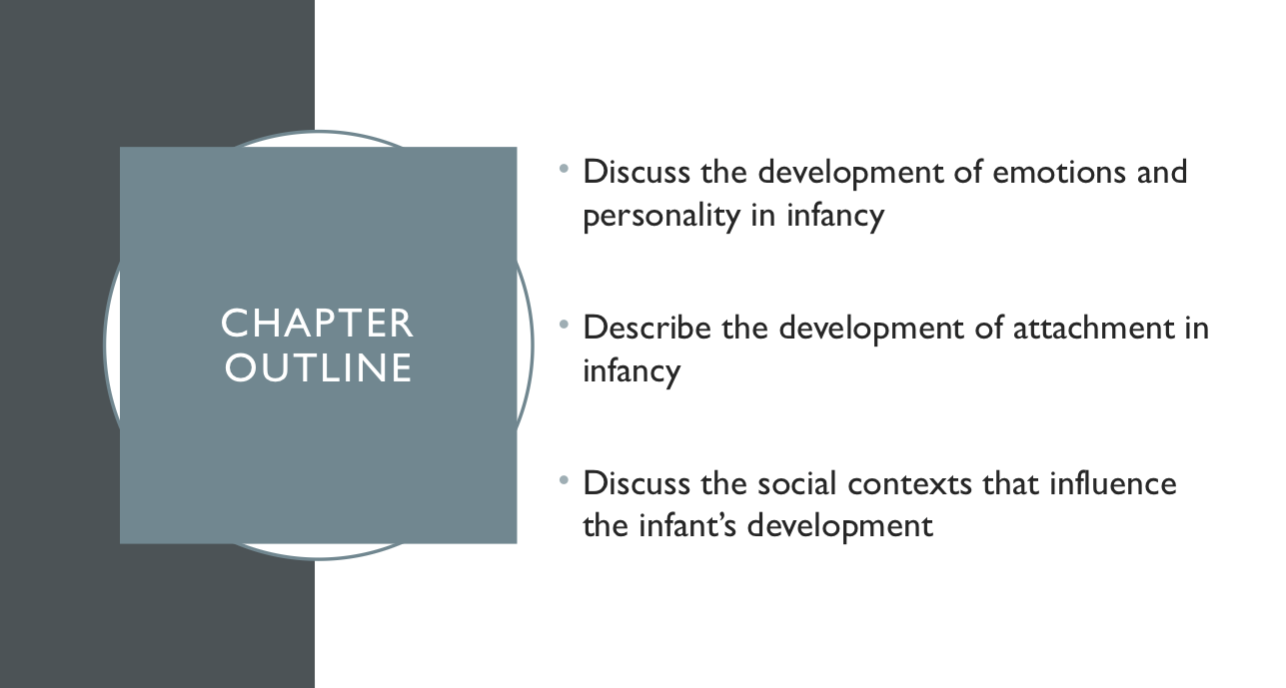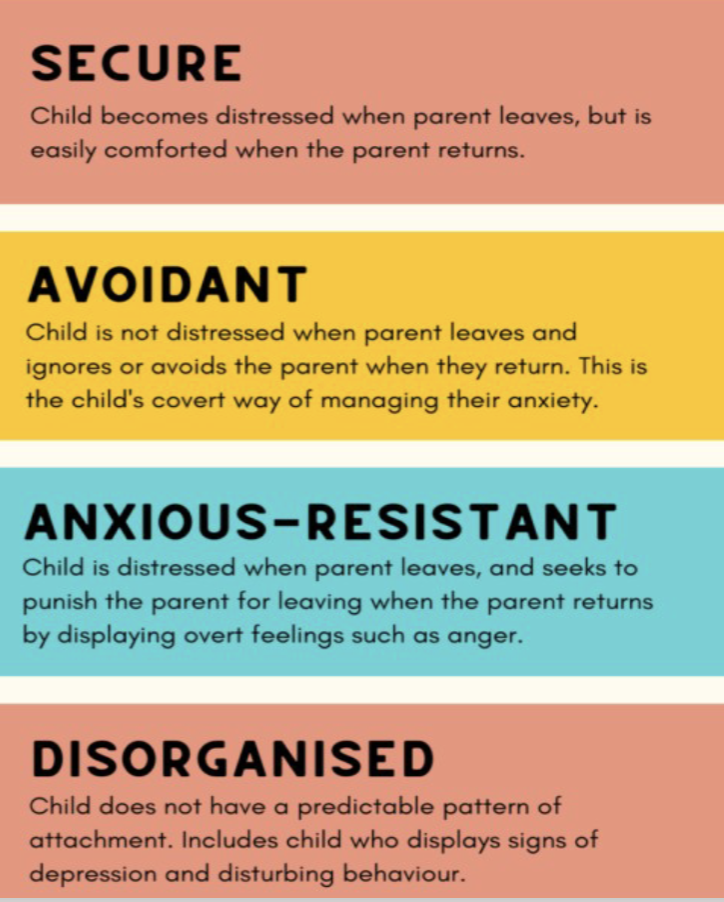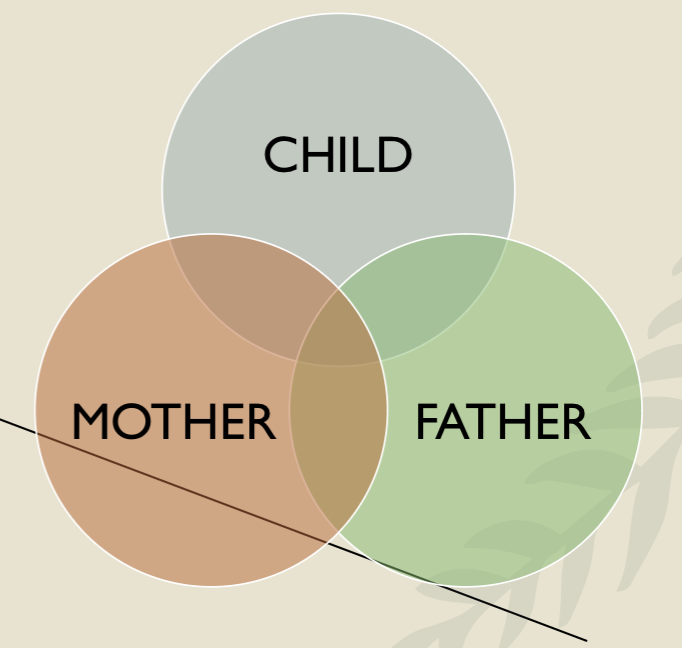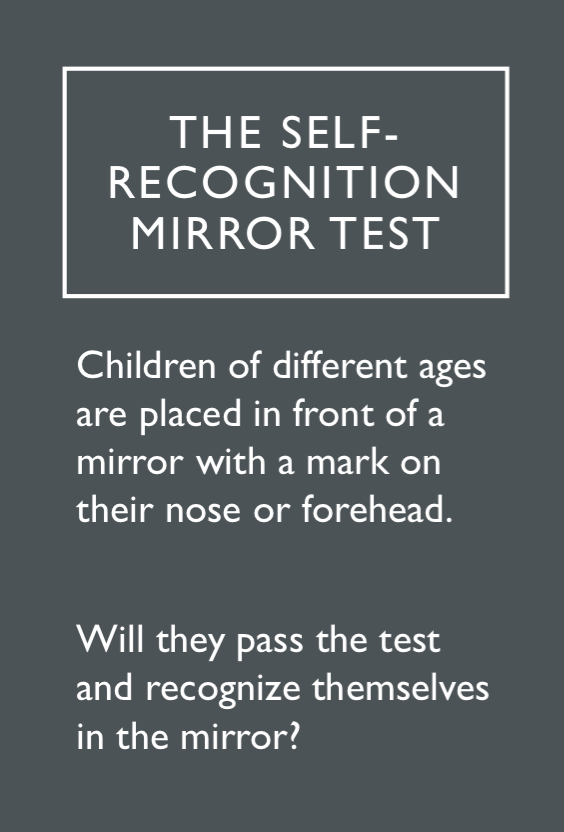Chapter 6

Emotional Development
Emotion: feeling, or affect, that occurs when a person is in a state or interaction that is important to them
Especially in nfancy, emotions play a role in:
Communication with others
Emotions communicate joy, sadness, interest, and fear
Behavioral organization
Emotions influence social responses and adaptive behaviors as they interact with others
Influences
Emotions ar einfluenced by biological foundations, cognitive processes, and a person’s experiences
Social relationships provide the setting for the development of a bigger variety of emotions
Toddlers observing how parents interact (arguing/yelling vs laughing/playing) allows them to develop emotional coping skills
Early Emotions
Primary emotions appear in the first 6 months of infant’s development
Suprise, interest, joy, anger, sadness, fear, and disgust
Self-conscious emotions require self-awareness, especially consciousness and a sense of “me”
Jealousy, empathy, embarrassment, pride, shame, and guilt
Occur for the first time during the second half of the 1st year or within the 2nd year
Emotional expression and Social Relationships
Ability of infants to communicate allow better interactions with their caregivers and form the beginnings of emotional bonds
Cries and smiles are 2 emotional expressions that infants display when interacting with parents
Crying
Crying is the most important mechanisim newborns have for communicating
The first cry verifies that baby’s lungs have filled with air
Babies have at least three types of cries:

Smiling
Smiling is a key social signal and very important aspect of positive social interactions
It is linked with social and intellectual development
Two types of smiling can be distinguished in infants:
Reflective smile - does not occur in response to external stimuli and appears during the first month after birth, usually during sleep
Social smile - occurs in response to external stimuli, typically a face in the case of a oyung infant. Begins to occur as early as 2 months of age
Temperament
Psychiatrists have identified three basic types, or clusters, of temperament:
An easy child is generally in a positive mood, quickly established regular routines in infancy, and adapts easily to new experiences
A difficult child reacts negatively and cried frequently, engages in irregular daily routines, and is slow to accept change
A slow-to warm-up child has a low activity level, is somewhat negative, and displays a low intensity of modd
In studies, about 35% of children did not fit into any of these three patterns
Another way of classifying temperament focuses on the difference between a shy, subdued, timid child, and a sociable, extraverted, bold child
Personality Development
Emotions and temperament form key aspects of personality - the enduring personal characteristics of individuals
Characteristics that are considered to be central to personality development during infancy:
Trust
The development of self
Independence
Trust
Erikson proposed that the first year of like is characterized by the trust-versus-mistrust stage of development
Infants learn trust when they are cared for in a consistent and warm manner
If the infant is not well fed and kept warm, a sense of mistrust is likely to develop
If the issue of trust vs mistrust is not resolved in the first year of life, it will arise again at each successive stage of development
The Developing sense of self
It is difficult to study the development of a sense of self in infants
The mirror test (or rogue test) found that most children younger than 1 year old do not recognize themselves in the mirror
Late in the second year and early into the third year, toddlers show other emerging forms of self-awareness
Refer to themselves by making “me/I” statements, declaring things are theirs
Independence
Erikson stressed that independence is an important issue in the second year of life
The second stage of development is autonomy vs shame and doubt
Autonomy builds as the infant’s mental and motor abilities develop
Infants can walk, climb, open and close, drop, push and pull, and hold and let go
Potty training is one fo the biggest milestones of this stage
Infant feels pride in each task when caregiver is supportive
However, if the caregivers are impatient and consistently criticize accidents, shame and doubt develop.
Attachment and its development
Attachment is a close emotional bond between two people
In infants, this lasting psychological connectedness is between a child and their primary caregiver
There are many theories about infant attachment;
Freud - infants become attached to the person that provides oral satisfaction
Harlow - contact comfort is preferred over food
Erikson - trust arises from physical comfort and sensitive care

Social context
The 2 main social contexts in which infants explore their emotional and personality development, as well as attachment are:
The family
Childcare
The Family
The family can be thought of as a constellation of subsystems - a complex which made up of interrelated, interacting, parts.
It is defined in terms if definition, gender, and role.
Each family member participates in several subsystems.
Father-child/ mother-child/ mother-father/ mother-father-child


